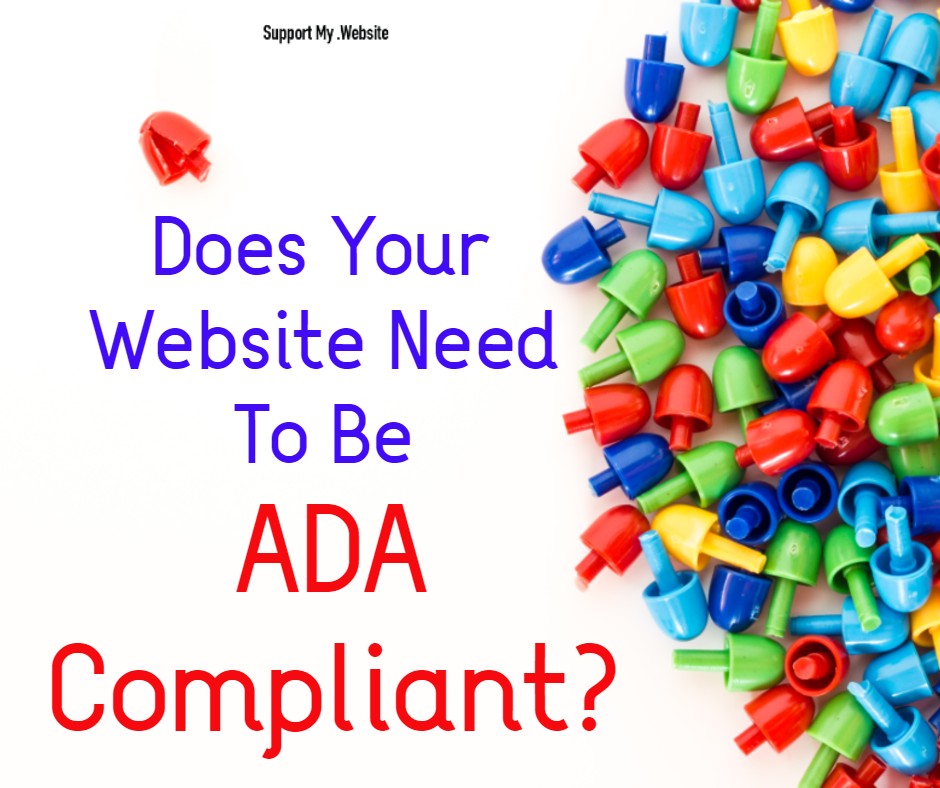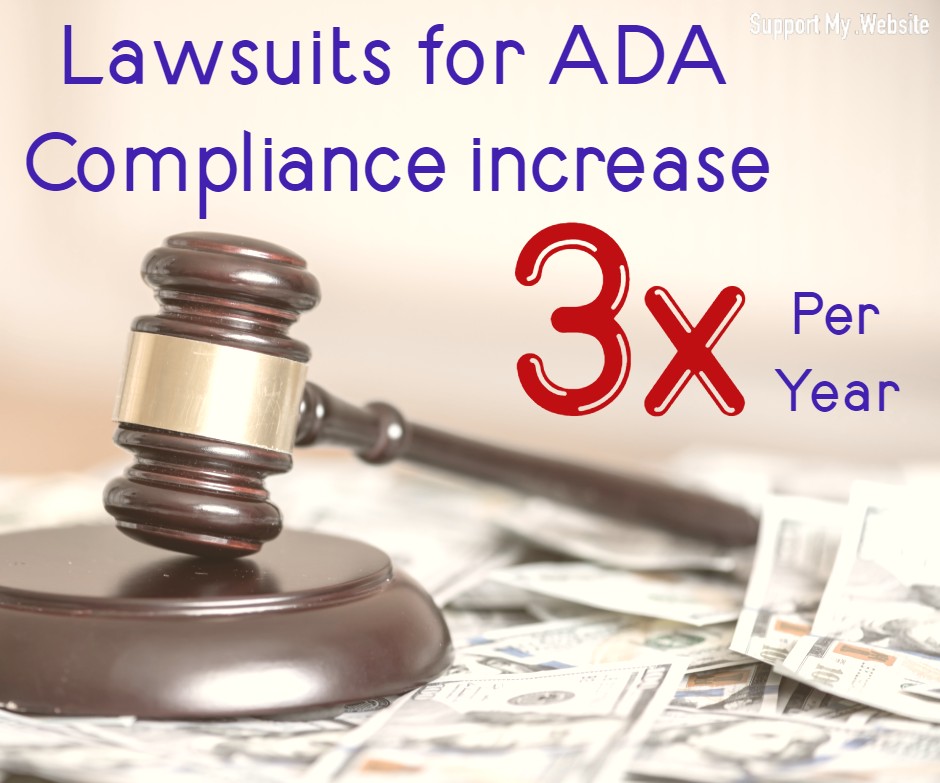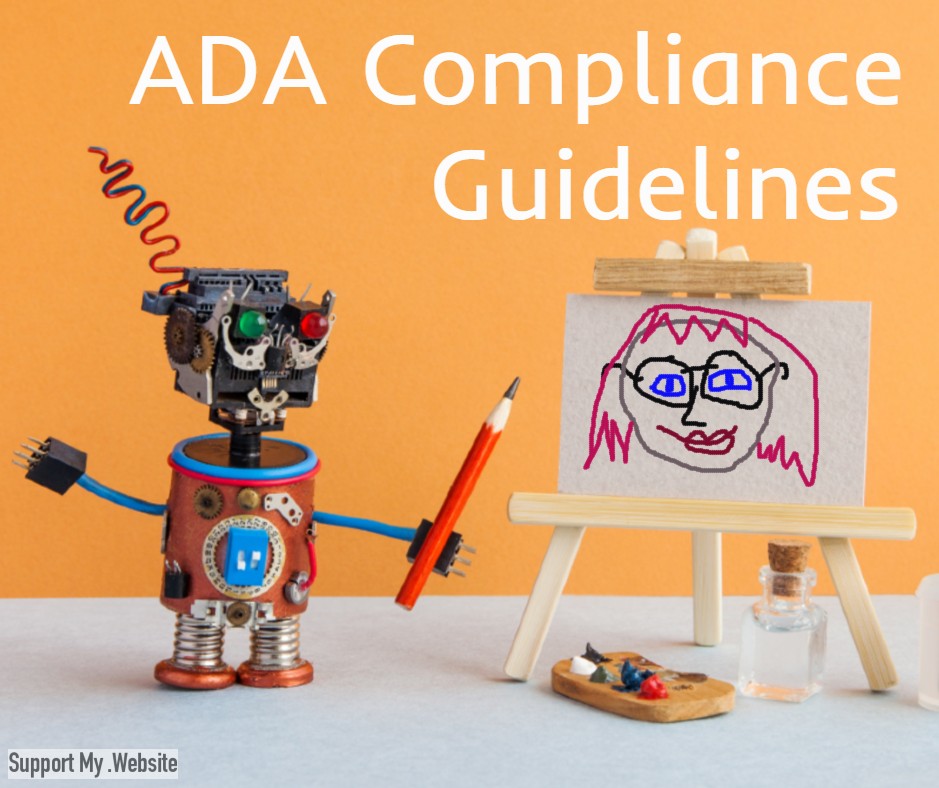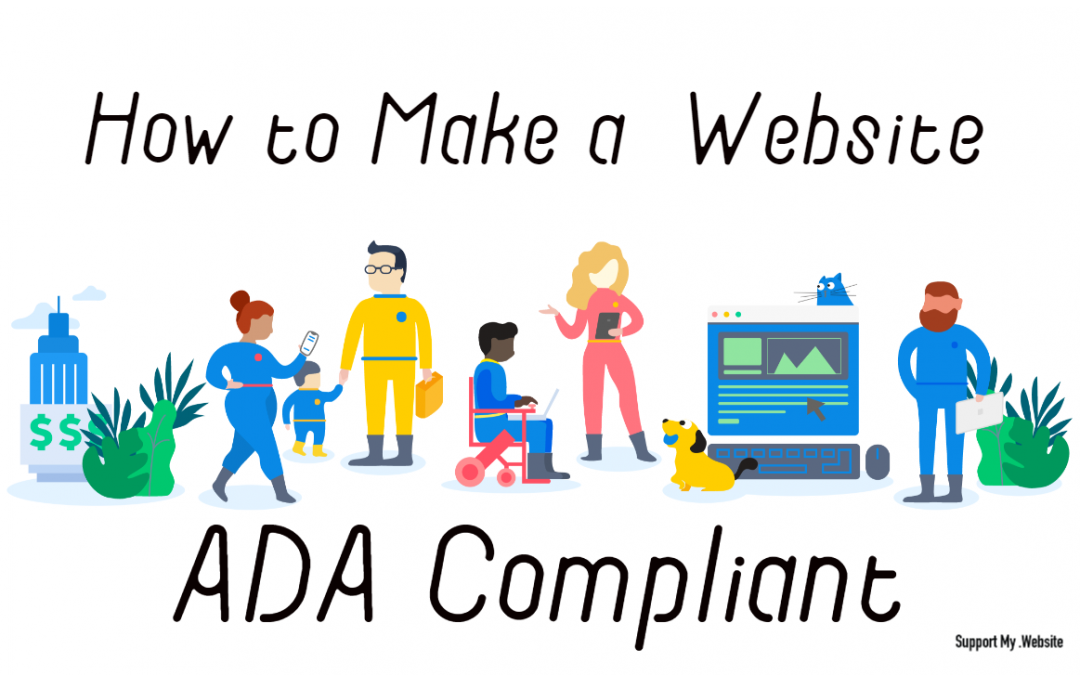Do Squarespace Websites Have ADA Compliance Built In?
Yes and no. Squarespace has ADA compliance and accessibility features coded into many of their templates. They also help keep your site in compliance by having responsive design options, resizable text, and multiple color and structure options.
That’s a good foundation, but it is up to you (and/or your web developer) to ensure that every aspect of the content you’re putting into the template is compliant.
In other words, Squarespace provides the tools, it’s up to you to use them in compliance with ADA standards.
Need help with your website compliance? Were are here to help!
Schedule a professional website compliance analysis today!
Does Your Site Need To Be Compliant?
The Americans with Disabilities Act recommends that every business follows their website compliance standards.

Did you know?
1 in 4 US adults has a disability according to the CDC.
If your business is working with federal or state money or your in an industry related to finance, government, education, or healthcare you have legal obligations to meet and maintain these compliance standards.
If your website does not fall into one of these categories, that doesn’t mean you are necessarily off the hook. Litigation surrounding website compliance is quickly becoming more defined while simultaneously including a broader range of businesses.
Legal obligations aside, making sure your website can be used by those with vision and mobility challenges improves your reputation, your rank, and your sales. So even if you don’t need to make your site compliant, you might want to consider it anyways.
Should You Use Accessibility Testing Services?
The short answer is probably. Just because your website is meeting compliance standards today, that doesn’t mean it will stay that way. Most websites have at least small changes regularly and assessing compliance manually is tedious.
Every time you make a change to your website, even something simple like adding a blog article or updating your team photo, you need to re-check your compliance. A single change can affect more than one page, even in ways you can’t see on the front-end.
Did you know?
Lawsuits for ADA website compliance nearly tripled from 2017 to 2018.

It’s a shame, but there are tons of people out there who make a living seeking out sites that are slacking on maintaining their legally required accessibility standards. They send a demand letter and almost always settle out of court.
If you’re legally required to keep your site compliant then it’s a no brainer, using an accessibility testing service is a must.
Can you keep tabs on everything yourself?
If you have a simple one-page website and you know your way around Squarespace pretty well, then this might be doable, but otherwise, it’s going to be time-consuming and tedious and it will almost certainly allow things to slip through the cracks.
If you don’t know much about code, then you’re likely to miss a lot of what’s happening in the background, and that affects your compliance.
How much does an accessibility testing service cost?
It depends on a few factors like:
- How many pages you have on your site
- The complexity of how it’s put together
- How often the site will be tested
- What kinds of items are being tested
Generally, a good accessibility testing service should start around $50 per month.
If you’re comparing compliance testing services, make sure you check out a dummy report. If the report isn’t easy to understand, it won’t be much use to you.
ADA Compliant Website Examples
There are tons of great examples of ADA compliant websites out there. To find some design inspiration for your website, check out some of the other major sites in your industry.
Here are some of our favorite examples of complaint sites:
How to Make and Keep Your Website Compliant
Whether you’re starting a site from scratch, or you’re reassessing a site that’s been around for years, there’s a lot to consider.
For a quick rundown, here are some of the main items to focus on.
- Page Titles
- Text (headings, spacing, links, etc)
- Images
- Audio
- Video
- Colors
- Navigation
Did You Know? Squarespace provides ADA compliance recommendations to help you make your site more accessible.
Check out the platform-specific recommendation and examples here.
What Are The Actual ADA Compliance Guidelines?
No need to guess, it’s all in black and white. The most recent version is WCAG 2.1 which was put in place in June 2018.

Here are the guidelines as of the time of this writing.
Section 1: Alternatives
- Alt text (1.1.1): All images and non-text content needs alt text (there are exceptions)
- Video & Audio alternatives (1.2.1): All video-only and audio-only content has a text transcript. Transcripts are clearly labeled and linked below the media.
- Closed captioning (1.2.2): All video with sound contains accurate closed captioning.
- Audio description (1.2.3): For any video, add an alternative video that includes an audio description of information not presented in the original video’s soundtrack (exceptions) or include a text.
- Live captions (1.2.4): Any live video presentations must have closed captions.
- Audio description (1.2.5): An audio description is optional under 1.2.3 level A but not in 1.2.5 AA.
Section 2: Presentation
- Website structure (1.3.1): Use proper markup techniques to structure your website’s content (e.g. use correct heading tags and HTML for ordered and unordered lists)
- Meaningful order (1.3.2): Present content in a meaningful order and sequence so that it reads properly.
- Sensory characteristics (1.3.3): When providing detailed instructions, make it so they aren’t reliant on a single sensory ability.
- Use of color (1.4.1): Do not rely on color alone to convey information.
- Audio control (1.4.2): Any audio must be able to be paused, stopped, or muted.
- Color contrast (1.4.3): There must be a color contrast ratio of at least 4.5:1 between all text and background.
- Text resize (1.4.4): Text must be able to be resized up to 200% without negatively affecting the ability to read content or use functions.
- Images of text (1.4.5): Do not use images of text unless necessary (e.g. logo).
Section 3: User Control
- Keyboard only (2.1.1): All content and functions on a website must be accessible by keyboard only (i.e. no mouse).
- No keyboard trap (2.1.2): Keyboard-only users must never get stuck on any part of the website; they must be able to navigate forwards and backward.
- Adjustable time (2.2.1): If there any time limits on a website, users have the ability to turn it off, adjust it, extend it.
- Pause, stop, hide (2.2.2): If there is content that blinks, scrolls, moves, users must have the ability to pause, stop, or hide it.
- Three flashes or below (2.3.1): Web pages do not contain anything that flashes more than three times in any one second period.
- Skip navigation link (2.4.1): A “Skip to Content” or “Skip Navigation” link allows users to bypass the heading and go straight to the main content.
Section 4: Understandable
- Page titles (2.4.2): Each page of a website needs to have a unique and descriptive page title.
- Focus order (2.4.3): Users must be able to navigate through a website in a logical sequential order that preserves meaning.
- Link anchor text (2.4.4): The purpose of each link should be clear based on its anchor text (e.g. don’t use “click here”)
- Multiple ways (2.4.5): There are multiple ways to access different pages/information on a website (e.g. search bar, nav menus, sitemap, breadcrumbs, helpful links after content).
- Descriptive headings and labels (2.4.6): Headings and programmatic labels must be clear and descriptive. They do not need to be lengthy.
- Focus indicator (2.4.7): Any “user interface control” that receives focus from a keyboard user should indicate that focus on the currently selected element (e.g. add a visible border around a text link).
- Website language (3.1.1): Set the language for your website.
- Language changes (3.1.2): Indicate any language changes for an entire page or within the content.
Section 5: Predictability
- No focus change (3.2.1): Nothing changes merely because an item receives focus; a user must actively choose to activate an item (e.g. hit enter to submit) before a change takes place.
- No input change (3.2.2): Nothing changes just because information is inputted into a field (e.g. form doesn’t auto-submit once all fields are filled out).
- Consistent navigation (3.2.3): Keep navigation layout consistent throughout all pages of the website (e.g. same links in the same order).
- Consistent identification (3.2.4): Components that have the same function within a website are identified consistently (but not necessarily identically) (e.g. two checkmarks can indicate two different things as long as their function is different — one indicates “approved” on one page but “included” on another).
- Error identification (3.3.1): Make any form errors easy to identify, understand, and correct.
- Form labels and instructions (3.3.2): Programmatically label all form or input fields so that a user knows what input and what format is expected.
- Error suggestions (3.3.3): If an input error is automatically detected, then suggestions for correcting the error should be provided.
- Error prevention on important forms (3.3.4): For pages that create legal commitments or financial transactions or any other important data submissions, one of the following is true: 1) submissions are reversible, 2) the user has an opportunity to correct errors, and 3) confirmation is available that allows an opportunity to review and correct before submission.
- Parsing (4.1.1): Make sure HTML code is clean and free of errors, particularly missing bracket closes. Also, make sure all HTML elements are properly nested.
- Name, role, value (4.1.2): For all user interface components (including forms, links, components generated by scripts), the name, role, and value should all be able to be programmatically determined; make sure components are compatible with assistive technology.
ADA Compliance for Your Squarespace Website Should Be a Priority
Your website is the public face of your business. It’s your responsibility to make sure you’re considering all of the needs of a business website including making sure everyone can use it.
Whether your site is on WordPress, Squarespace, Expression Engine, Drupal, or any other CMS, making sure it’s accessible should be a priority. Maintaining compliance is good for sales, it’s good for business, and it helps maintain the reputation of your company.
Need help keeping your site in compliance?
Schedule a free professional website analysis and get all your questions answered.
